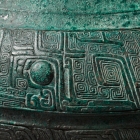J.J. Lally & Co., Oriental Art / New York City, New York
MenuPast Exhibition
Chinese Archaic Bronzes:
The Collection of Daniel Shapiro
March 14 - April 5, 2014
11.
POU 瓿
Shang Dynasty, 13th –12th Century B.C.
of high rounded form supported on a tall ring foot, decorated with a wide frieze of three taotie, each formed by a pair of kui dragons cast in flat relief, with large rounded protruding eyes confronted on a shallow vertical ridge, the elongated bodies and upturned tails of the dragons in the form of running scrolls and spurred quills surrounded by an intricate pattern of fine spiral scroll, with slender bodiless dragons marked by raised eyes descending at the borders of each taotie, below a running band of hook-beaked dragons with large bulging eyes, their bodies dissolved in intricate scroll pattern around the swelling shoulder, the sloping neck with three ‘bowstring’ bands rising to a wide mouth with everted rim, the slightly splayed flat sides of the foot pierced with three apertures aligned with the seams left by the edges of the casting mold segments above a border of paired spiral scroll motifs, the surface lightly encrusted all over with green malachite corrosion, interspersed with reddish olive-brown cuprite patina.
Width 13 inches (33 cm)
Provenance
From a Japanese Private Collection
Sotheby’s London, 14 November 2001, lot 4
J. J. Lally & Co., New York, 2004
A pou of very similar form and design, excavated at Xiejiagou, Qingjian county, Shaanxi province, now in the Suide County Museum is illustrated in Shaanxi chutu Shang Zhou qingtongqi, Vol. 1, Beijing, 1979, pl. 67, and the same pou is illustrated by Li (ed.), The Shaanxi Bronzes, Xi’an, 1994, p. 227, no. 187, described as Mid-Shang period.
Other pou of similar form and design are illustrated in The Complete Collection of Treasures of the Palace Museum: Bronze Ritual Vessels and Musical Instruments, Beijing, 2007, p. 123, no. 80, from the Qing Court Collection; by Girard-Geslan, Bronzes Archaïques de Chine, Paris, 1995, pp. 121–123, in the Musée Guimet, from the bequest of Marcel Bing; and by Butz, Frühe chinesische Bronzen aus der Sammlung Klingenberg, Berlin, 1993, pp. 46–47, no. 8.
商 瓿 寬 33 厘米

